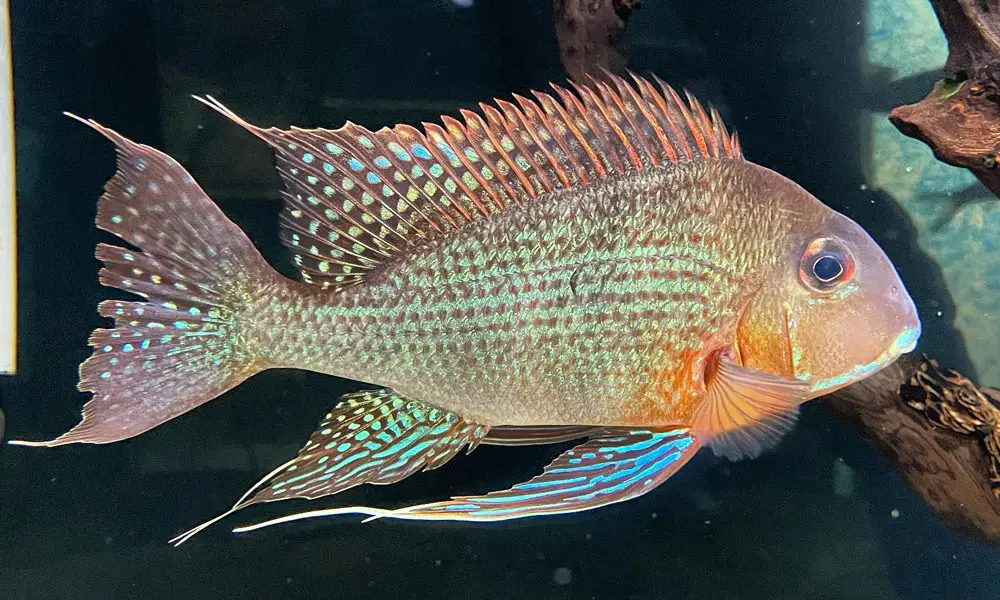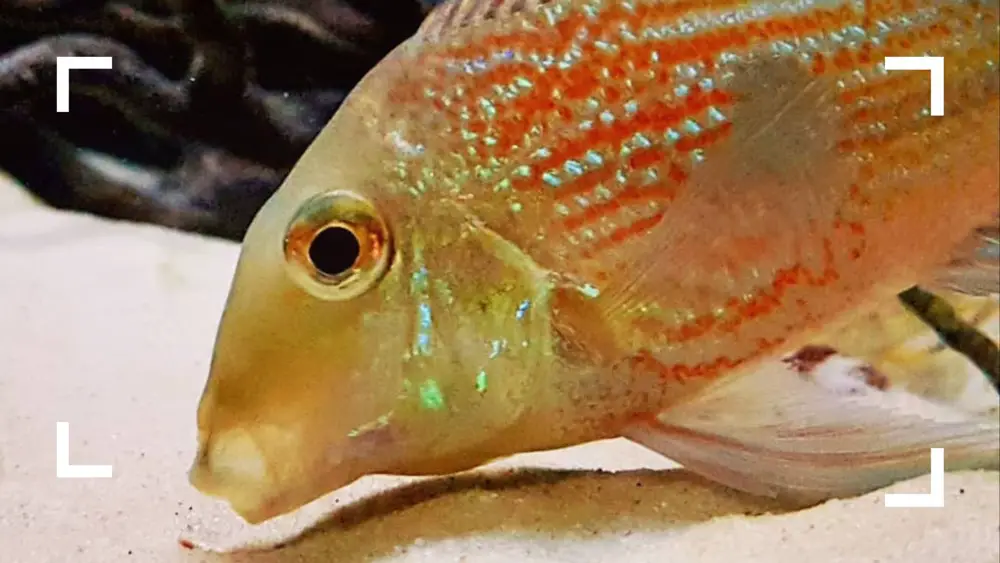Geophagus Altifrons is one of the popular freshwater fish in the aquarist community with its iridescent coloration and larger adult size. This eartheater cichlid species is Known for being hardy and easy to care for.
Since this fish is easygoing and relatively peaceful, making it a good choice among both new hobbyists and seasoned pros. To help them thrive in your aquarium, you need to understand their basic needs. For example, the Geophagus altifrons are benthophagous by nature and prefer clear and blackwater environments.
In this comprehensive guide, you will learn everything you need to know about Geophagus altifrons, including their preferred water conditions, maximum size, tank mates, and diet.
So if you are interested in keeping this beautiful eartheater cichlid species, keep reading to learn more!
Species Summary
Geophagus Altifrons are native to various streams and rivers in the middle-to-lower Amazon basin of South America, including Rio Negro, Rio Trombetas, Rio Madeira, Rio Paru, Rio Xingu, etc. It has been introduced into Singapore, where it mainly thrives in slow-moving streams and reservoirs.
Geophagus is a genus of cichlids that takes its name from the ancient Greek word for eartheater. These fishes are named so because of their unique feeding behavior, which involves sifting through the substrate in search of food. Geophagus includes over 30 described species, which vary widely in size and appearance.
These eartheaters, as they are often called, are found in South America, but only single species, Geophagus crassilabris, is found in Panama.
You might be interested in reading: Geophagus sveni (Sven’s Eartheater Cichlid) Species Profile
Geophagus altifrons in the aquarium trade are often misidentified as their close relative G. surinamensis (Red-striped eartheater), considered the most colorful “earth-eating” species.
Interestingly, unlike other popular freshwater species, G. altifrons don’t have a common name. It’s simply known by its scientific name.
| Scientific Name: | Geophagus altifrons |
| Common Name: | None |
| Care Level: | Beginner |
| Lifespan: | 10 years |
| Max Size: | 8.9 inches (22.5cm) |
| Temperature: | 77 – 86° F |
| PH: | 4.8 to 6.6 |
| Water hardness: | 0 – 8 Kh |
| Diet: | Omnivore |
| Minimum Tank Size: | 55 gallons (48″ x 13″ x 21″) |
| Temperament: | Peaceful |
Appearance

There’s no denying that Altifrons have an exciting look, and they are primarily known for their intense coloration. Their base color ranges from tan to gray, depending on the specimen you have collected. Geophagus Altifrons also feature very mild and vertical banding and iridescent scales on their flanks, ranging from gold-orange to blue-green.
Furthermore, these species have unique patterns on their operculum and various blue-green or orange-red marketing on their translucent fins. They also feature a black ocellus spot on and below their upper lateral line.
These altifrons have a pointed head and five rows of large scales that run along their dorsal side. The median dorsal fin is located between the third and fourth row. Geophagus Altifrons colors can range from oranges, blues, greens, reds, etc.
Geophagus Altifrons Size
G. Altifrons is known to be one of the largest Geophagus species.
The average size of Geophagus Altifrons is about 8.9 inches (22.5cm); however, they can grow up to 12” in the wild. While they can get a bit longer in the wild, most fish will max out at the standard length of 8.9 inches when kept in captivity.
Since juveniles are small, many potential owners presume them as small fish, but this is not the case.
Like most members of the eartheater genera, Geophagus Altifrons grow slow and steady. When they are sold, they are usually about 2-3 inches long. They can reach their full potential size in a year or two.
If you want these fish to grow to be as fast as possible, you will need to provide ample space, quality food, frequent water changes, and a higher temperature.
Lifespan
Geophagus Altifrons can live up to 10 years with optimal care and suitable tank conditions. In some instances, their life expectancy can increase by 15 years, but that’s a rare case in captivity.
Despite their long lifespan, they are not immune to health problems. Lack of reasonable care and poor conditions might affect their health, further cutting their lives short. So, feed them properly and keep them in good living conditions to make them survive for long.
Care and Tank Setup
In their natural habits, Geophagus Altifrons are found in shallow, slow-moving rivers, where mainly clear or black water with sandy and muddy substrates. Depending on their locality, these fish will often seek shelter in the nooks and crannies created by scattered rocks, submerged tree roots, and branches, or in other areas with plenty of covers.
Providing them an optimal level of care and replicating their natural habitat is still essential to ensure their good health and well-being.
To make things easier, we have gathered all the essential information about Geophagus Altifrons care and tank setup that you need to know before bringing them home.
Tank Size
The ideal tank size for a group of Geophagus Altifrons should be at least 55 gallons (48″ x 13″ x 21″). These fish do prefer to be in small groups of 5-8 individuals.
If you want to place them with other territorial Geophagus species, you will need to provide larger tanks.
Furthermore, a bigger space allows these fish to move freely around the aquarium and swim without any hindrance.
Water Parameters
Geophagus Altifrons is a type of fish that can display an array of different hues depending on the water quality. While their colors pop up with vibrance in softer water, they tend to fade and look worn out in hard water.
They prefer soft, acidic, warm, and clean black water conditions. Water quality and clarity are two of the most important care factors that you need to take into account since these species are highly susceptible to deteriorating water conditions.
Maintain these parameters, and you should have no problem keeping your fish healthy.
- pH: 4.8 to 6.6
- Temperature: 77 – 86° F
- Hardness: 0 – 8 Kh
- Ammonia: 0 ppm
- Nitrite: 0 ppm
- Nitrate: <30 ppm
To ensure their good health, you should maintain the water quality at its peak level by performing regular water changes and using a good filter system. It is recommended to perform minimum weekly water changes of up to 50-70%.
Having a quality aquarium surface skimmer is essential for maintaining healthy and clean water in your Geophagus Altifrons aquarium. These devices work by filtering out the solid waste and debris that can accumulate on the top of the water, ensuring that only clean and clear water remains.
Decor
The aquarium that houses this giant species must have a large expanse of soft sand substrates as these fish is eartheater and likes to sift through the substrate in search of food.
Live plants that are rooted in the substrate should be avoided as they might be uprooted or eaten. Instead, you can opt for some robust plants that are securely fastened to the driftwood or roots.
To provide Geophagus Altifrons with a natural feel, you should also add some driftwood and bogwood as well as smooth-edged stones in the tank. Be sure to clean and disinfect these items before adding them to the aquarium.
Subdued or dim lighting in the aquarium is also preferable.
Food & Diet
- New Life Spectrum is made from quality natural ingredients
- Extreme Color enhancement and vitality in your fish
- Made in the USA
Geophagus Altifrons are omnivorous and benthophagous by nature. They will accept most aquarium foods.
In the wild, they feed on small insects, insect larvae, crustaceans, worms, mollusks, snails, and other vegetable matter that they dig up from the substrate.
The foundation of their diet can be high-quality sinking fish flakes or pellets. To help grow healthy and strong, you can provide a nice mix of protein-rich food and vegetables.
Try to keep it varied by incorporating frozen foods, such as white mosquito larvae, brine shrimp, bloodworm, chopped prawns, krill, and Mysis.
But despite their voracious appetites, these fish often have trouble properly swallowing larger pieces of food, even as adults. This means their diet should mainly consist of smaller, easily digestible items.
Geophagus Altifrons Tank Mates
Geophagus Altifrons are generally peaceful and can be kept with other Geophagus species as long as there is plenty of space in the aquarium. They are also compatible with other most peaceful species enjoying similar water conditions.
This species is best housed in groups of 5 or more to form their natural hierarchy in species-specific aquariums.
Being a peaceful freshwater bottom dweller, Geophagus Altifrons spend most of their time near the bottom of the aquarium, so it’s best to avoid these aggressive bottom-dwelling species and fish inhabiting hard water.
Some potential tank mates for Geophagus Altifrons include:
- True Parrot Cichlid (Hoplarchus Psittacus)
- Small catfish
- Tetras
- Mikrogeophagus altispinosus (Bolivian Ram)
- Apistogramma
Final Thoughts
So, that’s all about the Geophagus Altifrons care guide. We hope you have enjoyed reading the post and found it informative.
Whether you are maintaining an aquarium with Geophagus altifrons or simply enjoy watching these colorful fish in their natural habitat, a solid understanding of their natural habits is key for providing proper care and keeping them happy and healthy at all times.
If you have any questions that were not answered in this care guide, or if you would like to share your own experiences with Geophagus altifrons, please don’t hesitate to leave us a comment below!






